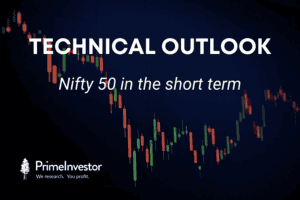- The Nifty 500 is close to its levels of 5 years ago.
- 483 of 500 stocks corrected from January 17, 2020 to April 3, 2020.
- All 500 stocks trade significantly below their all-time highs.
- Barring pharma, insurance, and gas, all sectors lose their gains from October 2018.
When you look at picking stocks, the future prospects of the stock, its valuation and fundamentals must play a large role. But in times such as the present crisis, none of these is complete without looking at the nifty correction itself. So, let’s take stock of where the nifty correction stands and how it compares with the last rally seen.

A few points to consider:
- For this analysis we considered the Nifty 500 index and stocks in Nifty 500 to get a better view of the breadth of the market.
- All data is as of April 3, 2020. There would have been movement post this date but it does not change the trend seen thus far.
- We took a few reference points for previous rallies. October 2018 to January 2020 and December 2016 to January 2020 were the 2 immediately previous rallies. The idea is to see if stocks have retained their gains from earlier rallies or lost out.
- Only the first section of this article talks of the index fall. Post that, when we refer to falls or gains, it is the average returns of the stocks or sectors in the index.
- This article is not aimed at providing any action or conclusion nor does it look at valuations. It is meant to observe market moves and put the correction in perspective
#1 Where is the Nifty 500 now?
The table below gives an idea of how much the correction has been as opposed to the nearest rally. October 2018 to the peak in January 2020 saw the Nifty 500 rally by just 20%. This return has been wiped out in the nifty correction in 2020 thus far.
| From | To | Nifty 500 returns |
| 17-Jan-20 | 03-Apr-20 | -34% |
| 26-Oct-18 | 17-Jan-20 | 20% |
| 26-Dec-16 | 17-Jan-20 | 50% |
| 26-Dec-16 | 03-Apr-20 | -1% |
| 01-Apr-15 | 03-Apr-20 | -6% |
Returns are absolute and not annualized
But how about from the earlier low in December 2016? No luck! Though the Nifty 500 returned 50% between December 2016 to mid-January 2020 peak, the steepness of the current nifty correction has wiped out all these gains. If we move back further, the 5 years ago returns too turned negative.
Bottomline: The present correction means that you have unwound your wealth status to that of 3.5 years ago, especially if you had invested in a diversified portfolio of stocks or a diversified equity fund.
#2 Did stocks retain their gains from previous rallies?
If the index has ceded all its gains, have all stocks suffered the same fate? The index is, after all, a basket of stocks with different weights.
So let’s know the quantum of stock fall from the January 2020 high.
- On an average, stocks in the Nifty 500 fell 38% (this is the average of individual stock declines and not the index) between January 17, 2020 high and April 3.
- 483 of 500 stocks fell
- The nifty correction (from January) is deeper in midcap and small-cap stocks at 36% and 41% respectively, compared with large-cap stocks at 32% (market-cap based on SEBI category)2 in every 3 stocks have lost their gains garnered from October 2018, as shown in the table below.
| Total no. of stocks | 439 |
| No. of stocks that rallied from October 2018 to January 2020 | 246 |
| No. of stocks from the 246 above that held to their gains until April 3, 2020 | 91 |
| No. of stocks that lost their gains post January 2020 | 155 |
| Stocks that never gained from October 2018 | 193 |
Source: Ace equity database
If we date back further to the December 2016 level, here again, the stocks lost 1% on an average. However, the good news is that 57% of the stocks that rallied from December 2016 have still managed to hold on to some of this gain even in this nifty correction.
For example, stocks like HDFC Bank or Bajaj Finance have given up 1.5 years’ worth of gains, but are still very much positive on a 3.5 year basis. On the other hand, stocks such as Axis Bank, Maruti Suzuki or SBI have been beaten down so much that you would have lost all gains made over the past 3.5 years.
| Company Name | 26-Oct-2018 to 03-Apr-2020 | 26-Dec-2016 to 03-Apr-2020 |
| Bajaj Finance Ltd. | -6% | 173% |
| Bajaj Finserv Ltd. | -16% | 72% |
| Kotak Mahindra Bank Ltd. | -2% | 60% |
| Tata Consultancy Services Ltd. | -8% | 44% |
| HDFC Bank Ltd. | -17% | 39% |
| ICICI Bank Ltd. | -9% | 27% |
| HDFC | -12% | 23% |
| Infosys Ltd. | -8% | 19% |
| Wipro Ltd. | -25% | 5% |
| HCL Technologies Ltd. | -16% | 3% |
| Ultratech Cement Ltd. | -10% | -2% |
| Larsen & Toubro Ltd. | -35% | -13% |
| ITC Ltd. | -37% | -21% |
| Maruti Suzuki India Ltd. | -40% | -22% |
| Axis Bank Ltd. | -39% | -25% |
| State Bank Of India | -29% | -28% |
| NTPC Ltd. | -40% | -40% |
| Indian Oil Corporation Ltd. | -42% | -48% |
| Coal India Ltd. | -51% | -52% |
| Oil & Natural Gas Corporation Ltd. | -54% | -63% |
Returns are absolute and not annualized. Source: Ace equity database
Bottomline: If you are an investor in the past 1-2 years, there is a high chance that you will be able to average stocks by buying now, provided you have done your homework on the fundamentals and what markets may fancy in the next rally.
#3 How about their all-time highs?
All the stocks are steeply off their all-time highs. But do note that it should not be the only criteria to choose stocks. Here are the statistics on it.
| Time of hitting NSE all time high | No. of stocks | Avg. returns from respective highs to April 03, 2020 |
| Before 2019 | 337 | -70% |
| 2019 | 58 | -48% |
| 2020 | 105 | -36% |
The sample below will tell you the swiftness of the correction, pulling down stocks from their recently hit highs in no time.
| Company | NSE All Time High Date | Return from all time high |
| Reliance Industries Ltd. | 20/Dec/2019 | -33% |
| Tata Consultancy Services Ltd. | 03/Sep/2019 | -28% |
| HDFC Bank Ltd. | 19/Dec/2019 | -38% |
| Hindustan Unilever Ltd. | 31/Mar/2020 | -7% |
| Housing Development Finance Corporation Ltd. | 14/Jan/2020 | -40% |
| ICICI Bank Ltd. | 30/Dec/2019 | -48% |
| Infosys Ltd. | 06/Sep/2019 | -31% |
| Kotak Mahindra Bank Ltd. | 19/Feb/2020 | -34% |
| ITC Ltd. | 10/Jul/2017 | -52% |
| State Bank Of India | 18/Jul/2019 | -53% |
Returns as of April 3, 2020. Returns are absolute. Source: Ace Equity database
Bottomline: The correction has been swift in terms of removing the froth that was building up in many stocks. For example, banks such as Axis Bank, ICICI Banks and SBI have halved in their price to book value between January and now. Others such as Infosys and TCS have moved from their early to mid 20s PE to 16-18 times trailing PE. Barring select FMCG, discretionary and pharma plays, across board, valuations are more in tune with trailing earnings than before.
#4 How are the sectors stacked up?
While several sectors rallied up to January 2020, it is evident now that the current pandemic has led the market to believe that only healthcare demand may remain undisturbed. It is for this reason that this space is untouched. So also insurance. In all other spaces, the sectors have given up their profits to the current bear market very swiftly.
| Sector | Average returns from Oct-18 to Jan-20 | Average returns from Oct-18 to Apr-20 |
| Healthcare | 16% | 5% |
| Insurance | 48% | 4% |
| Inds. Gases & Fuels | 42% | 4% |
| Gas Transmission | 43% | 3% |
| Consumer Durables | 30% | -6% |
| Chemicals | 21% | -8% |
| FMCG | 22% | -11% |
| Construction Materials | 28% | -12% |
| Realty | 39% | -27% |
| Agri | 13% | -29% |
| Telecom | 3% | -29% |
| IT | 7% | -31% |
| Logistics | 10% | -33% |
| Finance | 18% | -35% |
| Automobile & Ancillaries | 6% | -38% |
| Power | -2% | -38% |
| Capital Goods | 2% | -41% |
| Infrastructure | 8% | -48% |
| Iron & Steel | 4% | -49% |
| Banks | -1% | -50% |
| Non – Ferrous Metals | -16% | -57% |
Returns as of April 3, 2020. Returns are absolute. Source: Ace Equity database
Bottomline: There appears few industries unscathed by this nifty correction. Worse still, sectors such as banks, capital goods, non-ferrous metals, telecom, and IT that seem to have made little wealth over the past 1.5 years were only beaten down further, whether or not there is value in these pockets. Even in sectors such as banks, while select stocks built wealth, a majority of them saw eroding valuations leading to overall poor performance by the sector.
What does this nifty correction tell us?
- First, the good news is that the nifty correction is across board. This is unlike the falls in 2015, 2016 or the one in 2018, where the frothy segments remained protected and the rest were beaten down. That basically means that you can get opportunities in quality stocks without having to pay a very high price.
- Second, while it may seem like the correction was a swift one, compared with say 2008-09, it is not really so. A 32% fall in the Nifty 500 happened in 69 days then and 77 days now (from January 17, 2020).
- Third, if 2008-09 correction patterns were seen (we couldn’t go way back as Nifty 500 does not have a long history), we had at least 3 low points over 433 days before the real rally happened. If that repeats, you might have multiple points to dip into. Rushing into investing may not be required and may even hurt. Also, given that this crisis is different from a financial crisis that did not impact day-to-day lives, the uncertainty is a lot more now. More reason why stock picking, if done, needs high diligence.
Editor’s note: Did you read our earlier analysis on Nifty 50 levels to deploy your money and where to? If not, take up our trial or subscribe to read: https://www.primeinvestor.in/prime-strategy-at-what-nifty-levels-should-you-be-investing/
Use our Nifty 50 heat map to see the market snapshot of the last 20 years.







6 thoughts on “Prime Data Crunch: How deep is the nifty correction?”
Dear Vidya
Good article. In fact, Primeinvestor articles are currently used for making MF investments. It would be better if you finally somehow link the findings to a set of good MFs.
Btw, we are NOT looking forward to Primeinvestor stock suggestions. For this good site (love it!), it is just noise! We prefer MFs and stick to Index funds.
Hello Sir, Thank you! Rest assured the data will be considered in fund analysis and choice. These are just analysis carved out of those as getting a sense of the correction is important for many DIY investors.
On equities – point well taken 🙂 We will make sure we are the first, ‘no noise, quiet action’ place for equities to be used only as a diversifier for those who so desire 🙂 It will not be about short-term calls, gimmicy ‘case’ nor will it be about trading, which we are not good at anyway! 🙂 Thanks, Vidya
Hi Vidya, if possible can you share insights in a similar article with respect to the Equity large cap Prime Mutual Funds instead of stocks so that one can understand if it’s better to see beta or alpha as priority to make decisions before selecting a mutual fund in that category. Thanks
Hello Sir, we will write about how funds managed this downturn. Meanwhile, you might want to read this before deciding whether to go for largecaps. https://www.primeinvestor.in/multi-cap-funds-are-getting-less-risky/ thanks, Vidya
Bottom line of this article is PrimeInvestor should now add stocks in their services. Create a basket of stocks in smallcase.com for an additional annual fee. for a start let the basket be of stocks for risk averse first time investor through direct equity, looking for capital gains as well regular trickle of dividends. Go for it.
Hello Sir, we have promised stocks as part of our offering. It will come out in a few months. thanks, Vidya
Comments are closed.